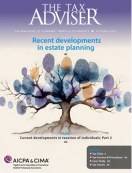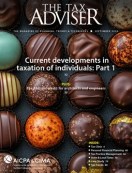The IRS issued final regulations addressing the basis of indebtedness of S corporations to their shareholders.
S Corporation Income Taxation
Making a Trust an Eligible S Corp. Shareholder: QSST and ESBT Elections
This item describes eligible shareholder trusts and the elections they must make.
Computing the Domestic Production Activities Deduction for Passthrough Entities
Some unique issues can arise when computing the domestic production activities deduction for a passthrough entity.
QSST Not Necessarily Required to Pay All Income to Beneficiary
If a qualified subchapter S trust (QSST) owns both S corporation stock and other assets, determining whether the income from the other assets must be distributed to the beneficiary depends on the terms of the trust document.
Installment Sale Rules and S Corp. Asset Sales: Planning for Better Results
When consulting on S corporation asset sales or sales treated as asset sales from a tax perspective, tax practitioners need to be aware that different tax consequences than expected can sometimes result under the installment sale rules of Sec. 453.
Final Rules Issued on Bona Fide Indebtedness and Terminating Partnership’s Startup Expenses
Final regulations were issued on S corporation shareholder basis of indebtedness of the S corporation to the shareholder only if the indebtedness is bona fide and on the deductibility of startup expenditures and organizational expenses for partnerships following a termination of a partnership.
Impact of Sec. 1411 on S Corporations and Their Shareholders
One of the more significant changes to the tax landscape in recent years is the new 3.8% tax on net investment income under Sec. 1411. This tax, which was further clarified in recently finalized regulations, will affect many entities and taxpayers including S corporations and their shareholders. This discussion outlines noteworthy aspects of these rules pertaining to S corporations and their owners.
Maintaining Single Taxation: Sec. 336(e) and S Corporations
Final regulations under Sec. 336(e) provide special rules for S corporations and their shareholders to make an election to treat a sale or disposition, including a distribution of control of a corporation’s stock of a qualified subsidiary, as a disposition of all the subsidiary’s assets.
Determining the Taxability of S Corporation Distributions: Part II
This article covers the taxability of distributions from an S corporation with accumulated E&P and ancillary issues and planning opportunities.
Late S Corp. Return Not an Income Disclosure Despite Reference in Stockholder’s Form 1040
When information disclosing income that should have been included in the taxpayer’s return is provided to the IRS after the return is filed, that information is not considered to be disclosed on the return.
Determining the Taxability of S Corporation Distributions: Part I
This two-part article provides a comprehensive review of the rules for determining the taxability of an S corporation’s distributions to its recipient shareholders. Part I provides an overview of the intent of Sec. 1368 and the related regulations, the shareholder- and corporate-level attributes that drive a distribution’s taxability, and the rules for determining the tax consequences of distributions made from an S corporation without accumulated earnings and profits.
The New Five-Year Built-In Gain Recognition Period
ATRA extended the five-year recognition period for the BIG tax to 2012 and 2013 and also changed the BIG tax treatment of installment sales and carryovers of built-in gain not taxed in the year recognized because of the taxable income limitation.
Electing S Corporation Status for a Limited Liability Company
In some situations, business owners have state-law reasons for wanting their business to be formed as a limited liability company, but for tax purposes they would prefer S corporation (rather than partnership) tax treatment.
S Corp. Members Are Not Subject to Controlled Group Sec. 179 Limitations
The IRS ruled that S corporation members of a controlled group may use the Sec. 179 election up to the maximum election amount as if they were separate entities, and are not subject to the controlled group’s overall limit.
Controlled Groups and the Sec. 179 Election for S Corporations
The exclusion of S corporations from component membership in controlled groups of corporations multiplies the planning opportunities for businesses under common control but calls for vigilance by tax professionals to use this deduction wisely.
Reasonable Compensation for S Corporation Shareholder-Employees
Two recent Tax Court opinions focusing on reasonable compensation for S corporation shareholder-employees provide important takeaways for owners and practitioners by addressing common issues surrounding distributions and loan repayments in the context of reasonable compensation.
Current Developments in S Corporations
This article discusses major changes and developments that directly affect S corporations and their tax advisers during the period of this update (July 10, 2012–July 9, 2013).
Sec. 179 Deduction Limitation Applied to S Corps. in a Controlled Group
The IRS recently released an information letter to clarify the treatment of the Sec. 179 limitations applied to members of a controlled group, in which certain members had made an election to be treated as an S corporation.
Chief Counsel Disregards Indemnification Agreements Under Anti-Abuse Rules in Transactions That Result in Disguised Sales
The Office of Chief Counsel advised that an indemnification agreement should be disregarded and, accordingly, the underlying partner contribution and distribution should be treated as a disguised sale.
Debt and Proving Basis in Flowthrough Entities
A taxpayer’s basis is often scrutinized by the IRS, particularly when basis is claimed based upon debts incurred by a flowthrough entity.
TAX PRACTICE MANAGEMENT
2025 tax software survey
AICPA members in tax practice assess how their return preparation software performed during tax season and offer insights into their procedures.














